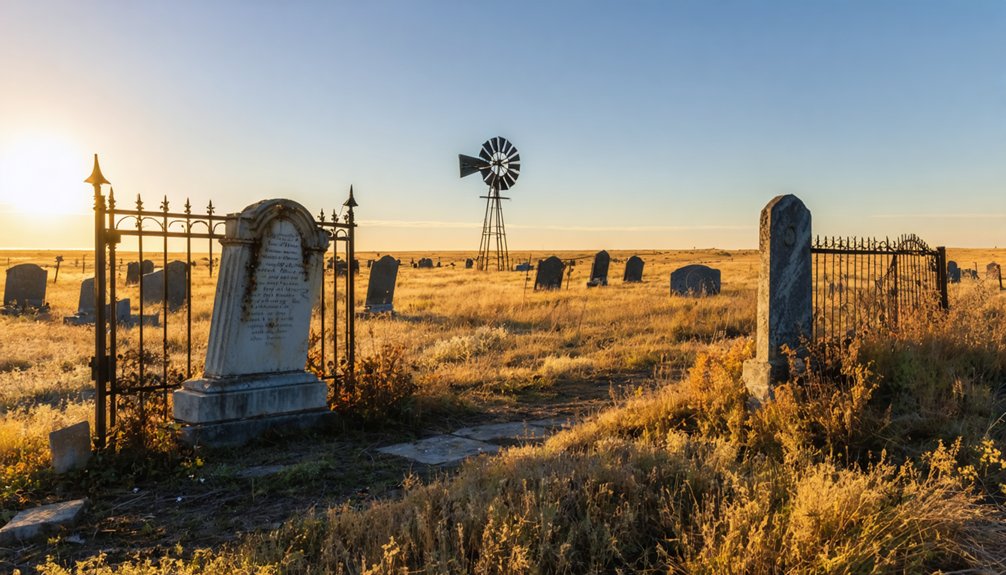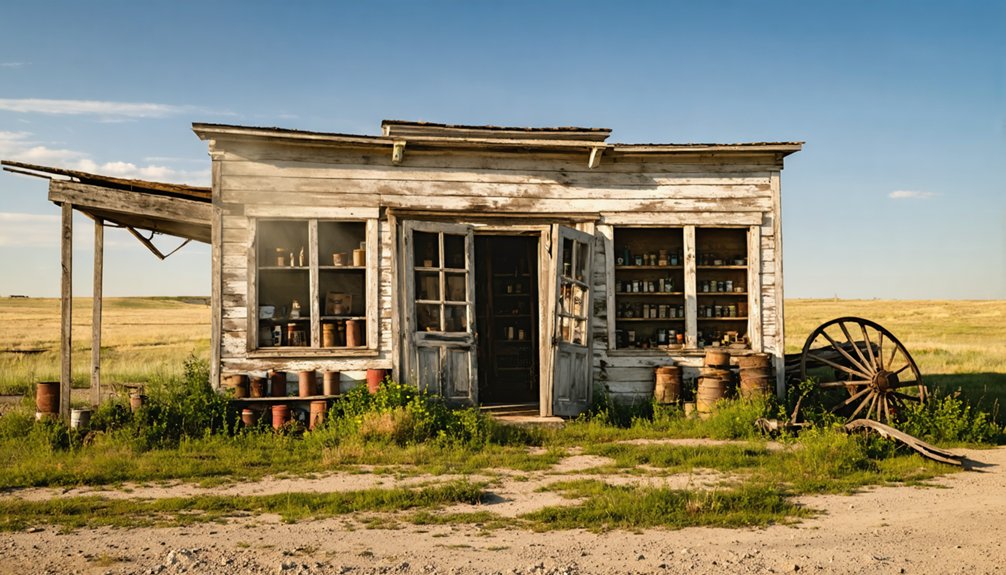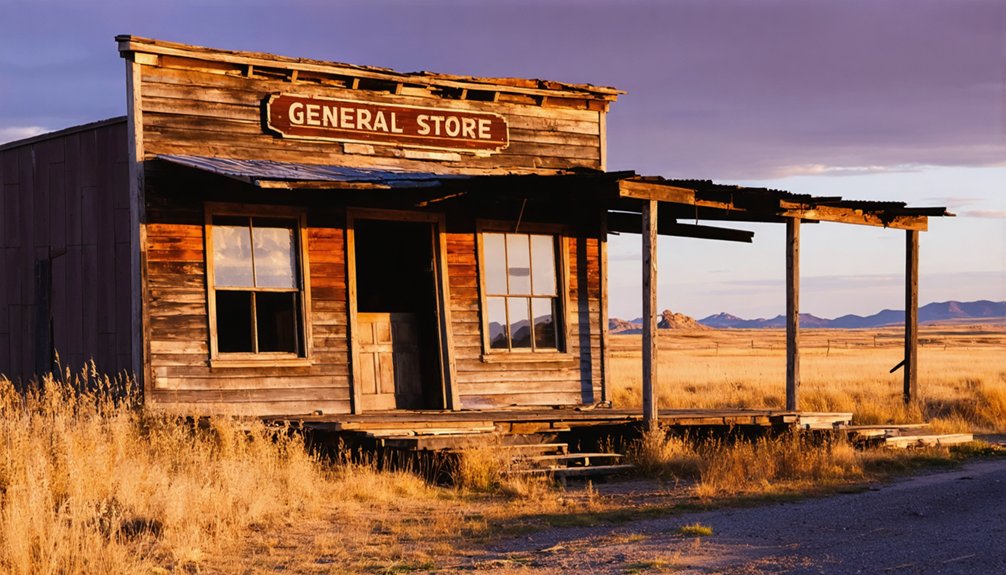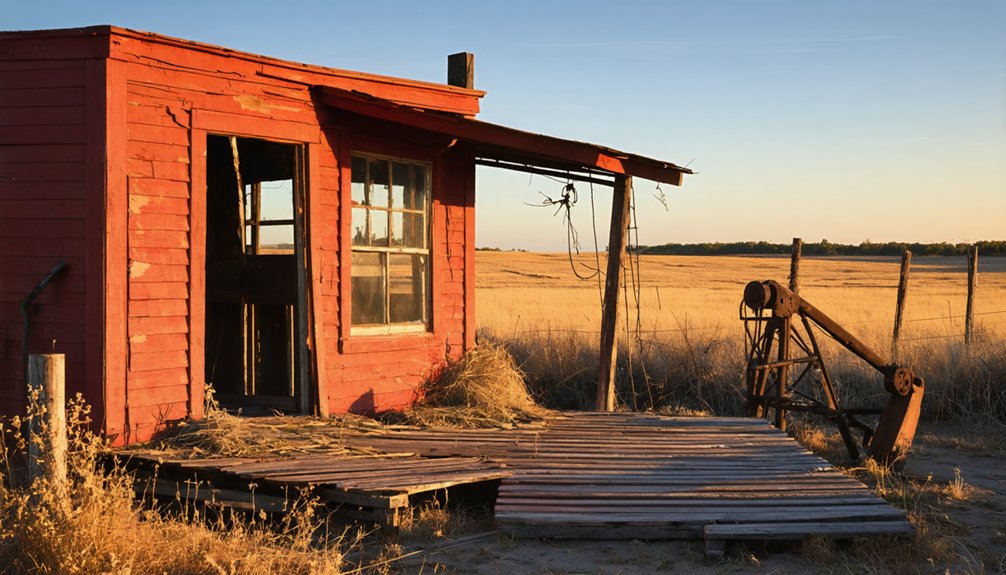You’ll discover Texas Town’s remarkable origins as a settlement established by escaped slaves from Texas around 1860 along the Missouri River in Dakota Territory. The community thrived through river trade and served miners during the Black Hills boom, becoming one of the rare Black settlements outside the South. While the railroad’s arrival in 1905 ultimately led to the town’s decline, its legacy lives on through preserved sites like Elmwood Cemetery, where countless stories of freedom and determination await.
Key Takeaways
- Texas Town began as a settlement of escaped African American slaves from Texas around 1860 near the Missouri River.
- The town flourished during mining booms and railroad expansion, serving as a hub for miners and railroad workers.
- Economic decline began when railroad routes bypassed the town between 1905-1907, leading to population loss and eventual abandonment.
- The Elmwood Cemetery remains a preserved historical site, reflecting the community’s Northern allegiance during the Civil War.
- Texas Town transformed from a bustling river trade settlement to a ghost town, now serving as a cultural tourism destination.
The Birth of a Freedom Settlement
While the Civil War raged in the South, a group of escaped African American slaves from Texas made their way north to Dakota Territory around 1860, establishing what would become known as Texas Town.
These brave individuals undertook dangerous freedom journeys to build new lives far from the oppressive clutches of slavery.
Through perilous paths and daring escapes, these courageous souls forged ahead, seeking liberty in distant lands beyond slavery’s reach.
You’ll find that Texas Town emerged as one of the rare Black settlements outside the traditional Southern freedmen communities.
Settling near the Missouri River, these pioneers demonstrated remarkable community resilience as they carved out an independent existence.
They chose this strategic location to take advantage of steamboat traffic, which provided both transportation access and economic opportunities.
Though written records are limited, oral histories tell of a determined people who transformed an untamed frontier into a symbol of Black self-determination.
Much like the early Ioway Tribe settlers of the region, they developed deep connections to the land and river.
Like many settlements formed during this era, the community built their lives around church and school to maintain unity and cultural bonds.
Life Along the Missouri River
If you’d walked along the Missouri River’s bustling banks in the late 1800s, you’d have seen steamboats loading and unloading cargo at Texas Town’s thriving dock.
The daily rhythm of river trade brought crucial supplies to the settlement while sending local goods downstream to markets in Yankton and beyond.
You’d have witnessed deckhands expertly maneuvering heavy freight while steamboat captains negotiated deals with local merchants, creating a significant economic lifeline that sustained the growing community.
The river’s role in westward expansion made settlements like Texas Town vital stopping points for pioneers and traders during the 19th century.
The river remains a vital resource today, with the Missouri National Recreational River offering prime opportunities for fishing, kayaking and wildlife viewing near Yankton.
River Trade Activities
Life along the Missouri River pulsed with vibrant trading activity in the early 1800s, anchored by strategic fur trading posts like Fort Manuel and Fort Union. By the 1830s, fur trading peaked before declining sharply due to overtrapping.
You’d find keelboats laden with trade goods pushing upstream, while timber rafts and furs floated downstream toward bustling markets. These river trade routes weren’t just about commerce – they created essential cultural exchanges between Native Americans and European settlers.
You could witness the transformation as steam-powered vessels revolutionized river transport, turning modest riverside settlements into thriving commercial hubs. The U.S. Army Corps conducted extensive river surveys to improve navigation for commercial vessels.
At crossing points, ferry operators charged fixed rates to move people, horses, and wagons across the Missouri. This dynamic era lasted until 1887, when the Great Northern Railway’s completion shifted the region’s economic landscape away from river-based commerce.
Daily Steamboat Operations
Three distinct crews kept Missouri River steamboats running during the challenging ice-free months from March through November.
You’d find the mates supervising roustabouts who pushed boats off sandbars, while firemen worked intense shifts monitoring dangerous boilers. These crews operated under tight steamboat schedules, racing against winter’s approach. Successful trips could earn captains up to $40,000 in profits from cargo transport.
At each river town, you’d witness the rapid loading and unloading of cargo, mail, and passengers. Regular packet boats followed strict timetables, while tramp steamers filled gaps in service. The river’s nickname Big Muddy made navigation especially treacherous for steamboat crews.
You’d see multiple vessels docked simultaneously during peak season, their crews working frantically to minimize downtime. The constant challenge was maintaining enough wood fuel and provisions, especially on long stretches between St. Louis and remote ports like Fort Benton.
Every stop mattered in the rush to complete as many profitable trips as possible.
Lumber Trade and River Commerce
While gold initially drew settlers to the Black Hills region, the abundant Ponderosa pine forests sparked a thriving lumber trade that would shape the area’s development.
You’d find sawmills dotting the landscape from Custer to Deadwood, with John Frances Murphy’s 1876 operation leading the way. Lumber production became essential for building everything from mining supports to settler homes. By 1900, twelve sawmills operated in Custer alone.
In towns like Mystic, you’ll discover how the industry evolved from horse-drawn logging to mechanized operations. The Sanford brothers’ sawmill, later owned by George Frink, became the town’s economic backbone after mining declined. Frink expanded operations by building tourist cabins in the 1920s to diversify the local economy.
While river navigation wasn’t extensively used for lumber transport, the arrival of railroads revolutionized distribution, connecting Black Hills timber to broader markets despite hefty freight charges of $6 per ton plus 75¢ freight.
Railroad’s Arrival and Economic Impact
You’ll find that when railroads crossed the Missouri River into West River South Dakota between 1905-1907, they dramatically shifted economic power away from river-based commerce.
As rail lines connected major towns like Pierre and Rapid City, businesses diverted their transportation funding from riverboat operations to railroad shipping.
Your local merchants who once depended on river trade had to either relocate near the tracks or watch their profits dwindle as railroad towns became the new centers of commerce.
Economic Shift Patterns
As railroads carved through South Dakota’s landscape in the late 19th century, they fundamentally reshaped the region’s economic geography and settlement patterns.
You’ll find that towns like Texas Town, which once thrived on river trade, couldn’t maintain their economic resilience when rail routes bypassed them in favor of new locations.
The transportation evolution proved ruthless – communities either adapted or vanished.
Railroad subsidiaries like the Western Town Lot Company strategically created new settlements along rail corridors, spacing them within a day’s travel of each other.
If you’d visited during the Great Dakota Boom (1878-1887), you’d have witnessed nearly 60% of new towns emerging from railroad development.
Those lucky enough to secure rail access, like Belle Fourche, flourished as shipping centers, while bypassed towns like Minnesela faded into ghost towns.
Transportation Funding Diverted
The massive funding shift toward railroad development in the early 1900s spelled doom for river-dependent towns like Texas Town. As transportation shifts favored rail networks, funding priorities directed both public and private capital away from river navigation and road development.
- Railroad companies received generous land grants and financial incentives to build extensive networks.
- Investment focused on rail lines that could transport grain and livestock year-round.
- State and federal resources were reallocated to support rail infrastructure.
- Partnerships between public and private entities prioritized rail over seasonal river transport.
- Capital flowed toward railroad construction, leaving river towns without needed infrastructure support.
You’ll find that these funding decisions transformed South Dakota’s landscape, determining which communities would thrive and which would vanish based solely on their proximity to the iron horse.
The Last Traces: Elmwood Cemetery

Nestled along the historic Military Road near Elk Point, Elmwood Cemetery stands as a silent witness to South Dakota’s pioneer heritage.
When you explore this ghost town site, you’ll find grave markers that tell stories of early settlers like Eli Wixson, who built the area’s first trading post in 1859. The cemetery’s preservation reveals Union County’s proud Northern allegiance – it was even renamed from Cole County during the Civil War to demonstrate loyalty.
You’ll discover family histories etched in stone, documenting the brave souls who settled near Fort Randall since 1857.
Today’s guided tours and presentations showcase Elmwood’s cultural significance, while genealogists use its records to trace ancestral lines. Despite the town’s disappearance, the cemetery remains a tangible connection to South Dakota’s frontier past.
African American Pioneers in Dakota Territory
While Elmwood Cemetery chronicles many pioneer stories, it shares ground with an often-overlooked chapter of Dakota Territory’s history.
African American homesteaders arrived seeking freedom and opportunity in these vast prairies, establishing pioneering communities that would shape the region’s future.
- Benjamin Blair became South Dakota’s first African American school board member, leading the way in local governance.
- The Sully County Colored Colony claimed over 20 successful homesteads.
- African American settlers prioritized education, establishing schools for their children.
- Many worked as entrepreneurs and land agents, building successful businesses.
- Notable figures like Era Bell Thompson went on to achieve national recognition.
You’ll find their legacy woven throughout Dakota Territory’s story, from Fort Pembina’s first non-Native birth in 1801 to the thriving communities they built through determination and entrepreneurial spirit.
From Bustling Port to Abandoned Site

Once a thriving Missouri River port established in 1860, Texas Town embodied the promise and peril of frontier settlements in Dakota Territory.
You’ll find its settlement dynamics reflected a classic pattern: rapid growth fueled by steamboat traffic and lumber trade, followed by an equally swift decline. The town’s bustling docks, warehouses, and commercial establishments served travelers and settlers alike during the 1860s, showcasing the community’s resilience in harsh frontier conditions.
But when railroads bypassed Texas Town around 1870, you’d have witnessed its gradual emptying as residents sought opportunities elsewhere.
Preserving a Vanished Community’s Legacy
You’ll find Texas Town’s legacy preserved through meticulous historical documentation, including archival records, oral histories, and physical site surveys that verify its past significance.
The cemetery site receives special protection through local preservation efforts, with careful attention paid to maintaining grave markers and protecting the grounds from vandalism or deterioration.
Through educational programs and interpretive signage, you can explore how the community’s memory lives on as local historians and preservation groups work to share Texas Town’s story with future generations.
Historical Documentation Methods
Because preserving the legacy of a vanished community requires meticulous attention to detail, historians employ an extensive array of documentation methods to capture every possible aspect of these lost places.
You’ll find that through oral histories and archival research, you can piece together the intricate stories of Texas Town’s former residents and their daily lives.
Here’s what you’ll need to document this vanished community properly:
- Conduct in-depth interviews with former residents and their descendants
- Search through property records, deeds, and local government documents
- Create detailed architectural drawings of remaining structures
- Develop GIS maps to analyze the town’s layout and development
- Build a digital archive of photographs and historical documents
These methods work together to create a thorough record that’ll preserve Texas Town’s story for future generations.
Cemetery Site Protection Efforts
While ghost towns fade into the landscape, their cemeteries stand as essential chronicles of community history that demand careful preservation.
You’ll find that effective cemetery maintenance requires regular monitoring of grave markers, securing the grounds against vandalism, and maintaining historically accurate landscape features. Partnering with local preservation commissions and historical societies strengthens your ability to protect these sacred spaces.
When you’re involved in historical preservation of ghost town cemeteries, you’ll need to document each element thoroughly and follow established conservation standards.
By forming support groups and securing funding through grants and partnerships, you’re ensuring these burial grounds continue telling their stories.
Community Memory Through Education
Through oral histories and educational programs, ghost towns maintain their essential connection to the present day.
You’ll discover a rich tapestry of community memory preserved through active engagement with descendants, historians, and local advocates. Whether you’re attending documentary screenings or participating in guided walks, these educational initiatives guarantee that vanished communities aren’t forgotten.
- Annual ghost town walks offer immersive experiences at historic sites
- Documentary screenings feature Q&A sessions with filmmakers and historians
- University partnerships produce valuable research and preservation projects
- Social media and digital platforms extend access beyond geographic boundaries
- Community gatherings foster intergenerational dialogue about local heritage
You’ll find oral histories particularly compelling, as they capture firsthand accounts of daily life, industry, and social structures.
These testimonials, combined with academic research and public events, create a lasting bridge between past and present.
Transportation Revolution’s Impact
As railroad tracks stretched across South Dakota’s vast prairie landscape in the late 19th century, they transformed Texas Town and countless other settlements from isolated outposts into vibrant commercial hubs.
You’d have witnessed a remarkable transportation evolution as rail connectivity replaced horse-drawn wagons and riverboats, bringing unprecedented prosperity to the region.
The railroad’s influence ran deep – you’d have found bustling depots serving as nerve centers for commerce and communication.
But when automobiles and trucks gained dominance after World War II, Texas Town’s fortunes shifted dramatically.
The rail line’s abandonment cut your community’s essential lifeline to external markets. Without trains to ship grain or receive supplies, the town’s economic foundation crumbled, leading to its eventual ghost town status.
Historical Significance in South Dakota

During the late 19th century, Texas Town emerged as an essential piece in South Dakota’s complex historical mosaic, representing the state’s dynamic era of mining booms and railroad expansion.
As you explore South Dakota’s rich mining heritage, you’ll discover how Texas Town played a significant role in shaping the region’s development and cultural identity.
- Served as an important hub for miners, merchants, and railroad workers during the Black Hills mining era
- Contributed to the establishment of major transportation and trade routes
- Preserved authentic architectural elements that showcase pioneer life
- Transformed into a cultural tourism destination with historical walking tours
- Maintains tangible connections to the state’s gold rush period through artifacts and structures
Today, Texas Town stands as a symbol of South Dakota’s pioneering spirit, offering you a glimpse into the raw ambition and determination that drove western expansion.
Frequently Asked Questions
What Happened to the Original Texas Town Cemetery Records and Burial Plots?
You won’t find cemetery preservation records or complete burial history from Texas Town’s original plots – they’re lost to time, with any remaining documentation fragmented between local archives and WPA records.
Were There Any Known Conflicts Between Texas Town Residents and Neighboring Communities?
You won’t find documented evidence of significant community relations conflicts or territorial disputes between Texas Town residents and their neighbors, as historical records don’t reveal any notable tensions during the town’s existence.
What Specific Crops or Agricultural Activities Sustained the Town’s Food Supply?
You’ll find that wheat, corn, oats, and barley dominated local crop diversity, with residents likely maintaining vegetable gardens and practicing common dryland farming agricultural techniques to sustain their food supply.
Did Any Notable Civil War-Era Artifacts Survive From Texas Town’s Early Days?
You won’t find documented Civil War artifacts from Texas Town. While residents might’ve carried possessions when escaping slavery, no physical items survived time’s passage, leaving only stories for historical preservation.
How Did Severe Dakota Territory Weather Patterns Affect the Town’s Development?
You’d find severe droughts and brutal winter storms crippled the town’s growth by disrupting crucial riverboat trade, destroying crops, and isolating settlers from essential supplies during the harsh Dakota Territory seasons.
References
- https://hpr1.com/index.php/feature/culture/festivals-of-history-in-south-dakota
- https://www.youtube.com/watch?v=Glucs_Rq8Xs
- https://www.geotab.com/ghost-towns/
- https://icatchshadows.com/okaton-and-cottonwood-a-photographic-visit-to-two-south-dakota-ghost-towns/
- https://www.sdpb.org/arts-and-culture/2019-08-02/a-conversation-about-vanished-south-dakota
- https://en.wikipedia.org/wiki/List_of_ghost_towns_in_South_Dakota
- https://www.youtube.com/watch?v=xtVV4Kg2UlE
- https://www.tshaonline.org/handbook/entries/freedmens-settlements
- http://historyculturebybicycle.blogspot.com/2017/07/historic-cemeterys-elmwood-cemetery.html
- https://en.wikipedia.org/wiki/Missouri_River



